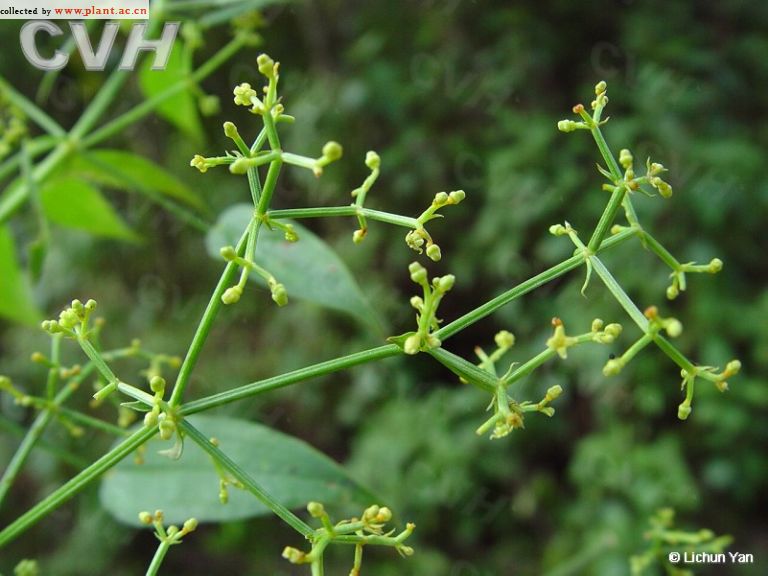柄花茜草Rubia podantha Diels
柄花茜草Rubia podantha Diels
24. 柄花茜草(云南种子植物名录)大茜草(云南文山),逆刺(云南丽江)图版71:7-12
Rubia podantha Diels in Not. Roy. Bot. Gard. Edinb. 5: 277. 1912; Levl. Cat. Pl. Yunnan 248. 1917; Hand. -Mazz. Symb. Sin. 7 (4): 1032. 1936; 云南种子植物名录, 下册: 1272. 1984.——R. nephrophylla Deb in Bull. Bot. Soc. Beng. 24 (1-2): 163, pl. 1. 1970, syn. nov.
草质攀援藤本;茎和分枝稍呈四棱形,棱上有倒生小皮刺,有时被糙毛。叶4片轮生,纸质,狭披针形或披针形,有时为卵形或长圆状卵形,偶有阔卵状近圆形,顶端短尖或渐尖,很少骤尖,基部心形,边缘通常有缘毛,干时通常褐色,下面基出脉上通常有倒生小皮刺,有时皮刺脱落仅存乳头状残基,通常仅上面被短糙毛,较少两面被短糙毛,有时仅上面基出脉上被短糙毛;基出脉3-5条,最外侧的2条常纤细,且伸至叶片中部消失;叶柄有直棱,有倒生皮刺,长1-5厘米左右。花序腋生和顶生,聚伞花序排成圆锥花序式,主轴和分枝均有直棱,被短糙毛或近无毛,通常比叶长;小苞片披针形或近卵形,长3-5毫米,渐尖或短尖,多少被糙毛,很少近无毛;萼管近球形,径约0.8毫米,近无毛;花冠紫红色或黄白色,干时常变褐色,杯状,外面通常稍被短硬毛,冠管高约0.8-1毫米,裂片5,卵形至披针形,长约1毫米,有时达1.5毫米,强烈反折,顶端尾尖至短渐尖,有3脉,里面密被小乳突。浆果球形,单生或孪生,直径约4-5毫米,成熟时黑色。花期4-6月,果期6-9月。
我国特有,产广西西部、四川西南部和云南;常生于海拔1000-3000米处的林缘、疏林中或草地上。模式标本采自云南丽江。
据 H. Hara (Sci. Rep. Tohoku Univ. Ser. N (Biol.) 29: 259. 1963) 的意见,本种与产于我国西藏、印度东北部、不丹和缅甸等地的 R. manjith Roxb. ex Flem. 极近似,区别只是本种花冠5裂至中部,冠管杯状。
R. nephrophylla Deb 的模式标本(W. Hancoc s. n ) 产于云南蒙自,根据原始记载和所附图形,它的花冠裂片反折,枝、叶被糙硬毛都和本种相同。虽然它有些叶片近圆形,在我们所见的本种标本中极少(包括蒙自标本),但可视为一种变体,叶子形状的变异在本属中是常见的。
《Flora of China》 Vol. 19 (2011)
Rubia podantha Diels Notes Roy. Bot. Gard. Edinburgh. 5: 277. 1912.
柄花茜草 bing hua qian cao
Rubia nephrophylla Deb.
Plants herbaceous, perennial, erect or ± climbing, with rootstock and rhizomes; stems to 1.2 m, quadrangular, glabrous to strigose, with retrorsely aculeolate ribs or narrow wings. Leaves in whorls of 4(or 6), sometimes unequal; petiole 1-5 cm; blade drying papery to subleathery, reddish abaxially or brownish green, lanceolate, lanceolate-ovate, or oblong-ovate, 1.5-5 × 0.5-1.5 cm, length/breadth index 2.5-3.5, both surfaces glabrous, strigillose, or strigose and sparsely to densely scaberulous, base truncate to cordate, margin serrulate-aculeolate or ciliate, apex acute to acuminate; principal veins 3 or 5, palmate. Inflorescences thyrsoid, paniculate, with terminal and axillary, ± many-flowered cymes, axes strigillose to glabrous; aculeolate; bracts lanceolate, 1-5 mm; pedicels 1.5-4 mm. Ovary ca. 0.8 mm, subglabrous. Corolla purplish red or yellowish white, campanulate, glabrous to sparsely hirsutulous; fused part 0.8-1 mm; lobes ovate to lanceolate, 1-1.5 mm, strongly reflexed, caudate to shortly acuminate. Mericarp berry black at maturity, 4-5 mm in diam. Fl. Apr-Jun, fr. Jun-Sep.
● Forest margins, sparse forests, grasslands; 700-3000 m. W Guangxi, W Sichuan, Yunnan.
The type specimens of Rubia podantha collected by Forrest from the Lichiang Range, Yunnan, are described in the protologue as semiscandent, with leaves lanceolate, base cordate, reddish below, and somewhat campanulate purplish flowers. This corresponds well with the figure in H. S. Lo (in FRPS 71(2): 317, t. 71, f. 7-12. 1999) and with a specimen collected from the type locality by Handel-Mazzetti in WU. Thus, R. podantha belongs to R. ser. Cordifoliae and appears related to other species with campanulate flowers, as R. alata or R. ovatifolia. It shares the reddish hue with the always scandent R. manjith, which has broader leaves and smaller, rotate flowers.The type specimens of Rubia podantha collected by Forrest from the Lichiang Range, Yunnan, are described in the protologue as semiscandent, with leaves lanceolate, base cordate, reddish below, and somewhat campanulate purplish flowers. This corresponds well with the figure in H. S. Lo (in FRPS 71(2): 317, t. 71, f. 7-12. 1999) and with a specimen collected from the type locality by Handel-Mazzetti in WU. Thus, R. podantha belongs to R. ser. Cordifoliae and appears related to other species with campanulate flowers, as R. alata or R. ovatifolia. It shares the reddish hue with the always scandent R. manjith, which has broader leaves and smaller, rotate flowers.
别名:红丝线;柄叶茜草;钩毛茜草;活血草;大蕊茜草;逆刺;红花茜草;大茜草;达仑木;
科名:茜草科 Rubiaceae
属名:茜草属 Rubia

24. 柄花茜草(云南种子植物名录)大茜草(云南文山),逆刺(云南丽江)图版71:7-12
Rubia podantha Diels in Not. Roy. Bot. Gard. Edinb. 5: 277. 1912; Levl. Cat. Pl. Yunnan 248. 1917; Hand. -Mazz. Symb. Sin. 7 (4): 1032. 1936; 云南种子植物名录, 下册: 1272. 1984.——R. nephrophylla Deb in Bull. Bot. Soc. Beng. 24 (1-2): 163, pl. 1. 1970, syn. nov.
草质攀援藤本;茎和分枝稍呈四棱形,棱上有倒生小皮刺,有时被糙毛。叶4片轮生,纸质,狭披针形或披针形,有时为卵形或长圆状卵形,偶有阔卵状近圆形,顶端短尖或渐尖,很少骤尖,基部心形,边缘通常有缘毛,干时通常褐色,下面基出脉上通常有倒生小皮刺,有时皮刺脱落仅存乳头状残基,通常仅上面被短糙毛,较少两面被短糙毛,有时仅上面基出脉上被短糙毛;基出脉3-5条,最外侧的2条常纤细,且伸至叶片中部消失;叶柄有直棱,有倒生皮刺,长1-5厘米左右。花序腋生和顶生,聚伞花序排成圆锥花序式,主轴和分枝均有直棱,被短糙毛或近无毛,通常比叶长;小苞片披针形或近卵形,长3-5毫米,渐尖或短尖,多少被糙毛,很少近无毛;萼管近球形,径约0.8毫米,近无毛;花冠紫红色或黄白色,干时常变褐色,杯状,外面通常稍被短硬毛,冠管高约0.8-1毫米,裂片5,卵形至披针形,长约1毫米,有时达1.5毫米,强烈反折,顶端尾尖至短渐尖,有3脉,里面密被小乳突。浆果球形,单生或孪生,直径约4-5毫米,成熟时黑色。花期4-6月,果期6-9月。
我国特有,产广西西部、四川西南部和云南;常生于海拔1000-3000米处的林缘、疏林中或草地上。模式标本采自云南丽江。
据 H. Hara (Sci. Rep. Tohoku Univ. Ser. N (Biol.) 29: 259. 1963) 的意见,本种与产于我国西藏、印度东北部、不丹和缅甸等地的 R. manjith Roxb. ex Flem. 极近似,区别只是本种花冠5裂至中部,冠管杯状。
R. nephrophylla Deb 的模式标本(W. Hancoc s. n ) 产于云南蒙自,根据原始记载和所附图形,它的花冠裂片反折,枝、叶被糙硬毛都和本种相同。虽然它有些叶片近圆形,在我们所见的本种标本中极少(包括蒙自标本),但可视为一种变体,叶子形状的变异在本属中是常见的。
《Flora of China》 Vol. 19 (2011)
Rubia podantha Diels Notes Roy. Bot. Gard. Edinburgh. 5: 277. 1912.
柄花茜草 bing hua qian cao
Rubia nephrophylla Deb.
Plants herbaceous, perennial, erect or ± climbing, with rootstock and rhizomes; stems to 1.2 m, quadrangular, glabrous to strigose, with retrorsely aculeolate ribs or narrow wings. Leaves in whorls of 4(or 6), sometimes unequal; petiole 1-5 cm; blade drying papery to subleathery, reddish abaxially or brownish green, lanceolate, lanceolate-ovate, or oblong-ovate, 1.5-5 × 0.5-1.5 cm, length/breadth index 2.5-3.5, both surfaces glabrous, strigillose, or strigose and sparsely to densely scaberulous, base truncate to cordate, margin serrulate-aculeolate or ciliate, apex acute to acuminate; principal veins 3 or 5, palmate. Inflorescences thyrsoid, paniculate, with terminal and axillary, ± many-flowered cymes, axes strigillose to glabrous; aculeolate; bracts lanceolate, 1-5 mm; pedicels 1.5-4 mm. Ovary ca. 0.8 mm, subglabrous. Corolla purplish red or yellowish white, campanulate, glabrous to sparsely hirsutulous; fused part 0.8-1 mm; lobes ovate to lanceolate, 1-1.5 mm, strongly reflexed, caudate to shortly acuminate. Mericarp berry black at maturity, 4-5 mm in diam. Fl. Apr-Jun, fr. Jun-Sep.
● Forest margins, sparse forests, grasslands; 700-3000 m. W Guangxi, W Sichuan, Yunnan.
The type specimens of Rubia podantha collected by Forrest from the Lichiang Range, Yunnan, are described in the protologue as semiscandent, with leaves lanceolate, base cordate, reddish below, and somewhat campanulate purplish flowers. This corresponds well with the figure in H. S. Lo (in FRPS 71(2): 317, t. 71, f. 7-12. 1999) and with a specimen collected from the type locality by Handel-Mazzetti in WU. Thus, R. podantha belongs to R. ser. Cordifoliae and appears related to other species with campanulate flowers, as R. alata or R. ovatifolia. It shares the reddish hue with the always scandent R. manjith, which has broader leaves and smaller, rotate flowers.The type specimens of Rubia podantha collected by Forrest from the Lichiang Range, Yunnan, are described in the protologue as semiscandent, with leaves lanceolate, base cordate, reddish below, and somewhat campanulate purplish flowers. This corresponds well with the figure in H. S. Lo (in FRPS 71(2): 317, t. 71, f. 7-12. 1999) and with a specimen collected from the type locality by Handel-Mazzetti in WU. Thus, R. podantha belongs to R. ser. Cordifoliae and appears related to other species with campanulate flowers, as R. alata or R. ovatifolia. It shares the reddish hue with the always scandent R. manjith, which has broader leaves and smaller, rotate flowers.

